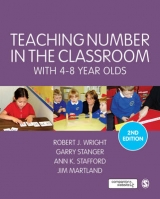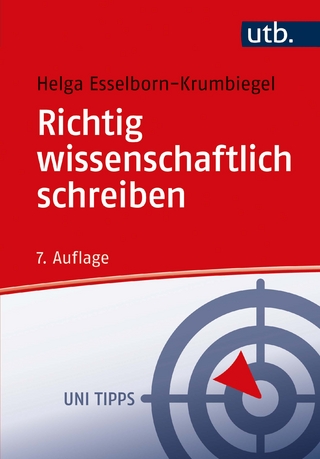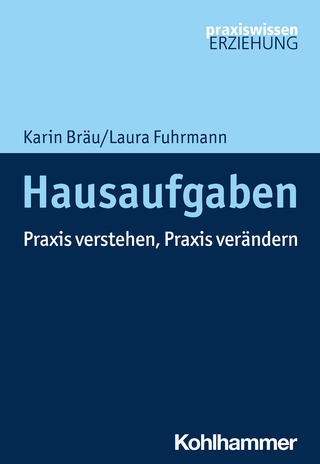
Teaching Number in the Classroom with 4-8 year olds
SAGE Publications Inc (Verlag)
978-1-4129-0757-6 (ISBN)
- Titel erscheint in neuer Auflage
- Artikel merken
`At last a book is written by teachers for teachers based on sound research that will generate enquiry based learning. It is essential for every classroom with lots of mathematical activities. These will purposefully engage children and allow for differentiation for those who require additional support to understand the number system and the more able children who require to be challenged. Mathematical standards in our schools will improve tremendously following these instructional activities′ - Carole Cannon, Development Officer for Mathematics Recovery
′This book ′Teaching Number in the Classroom with 4-8 year olds′ is an absolute "must have" for all educators involved in early number. Based on sound theoretical foundations, it offers a wealth of down-to-earth, tried and tested, effective approaches to teaching early number concepts and skills. It is a clearly a book written by teachers for teachers. Every single activity in the book is a nugget. Engaging with these activities will change your whole approach to teaching early number′ - Noreen O′Loughlin, Associate Vice-President/Lecturer in Maths Education, Mary Immaculate College, University of Limerick, Ireland.
′The authors prove it is possible to write a teacher friendly/teacher useful mathematics book that connects theory and practice. This book may become the primary teacher′s "Math Bible"′ - Angela Giglio Andrews, Primary Intervention Specialist and Coordinator, and Assistant Professor of Mathematics Education, National Louis University
′Teaching Number in the Classroom translates years of research into a very understandable and comprehensive approach for teaching children how the number system is structured and how to think like a mathematician.
For too many years there has been the perception that children who are struggling with mathematics don′t know the basic facts. The reality is that these children lack number knowledge and skills. Teaching Number in the Classroom will guide the educational professional through the steps of understanding the development of "number sense", identifying the current levels of knowledge and providing instruction that helps children use the "framework of mathematics" to solve number problems.
Teaching Number in the Classroom is a thinking skills approach to mathematics. Children are taught a variety of strategies for solving mathematical problems. The teacher using this book will be able to help all children develop a strong foundation of mathematical understanding′ - Carol Meland, K-3rd Grade Principal for the School District of Milton Wisconsin, USA
Teaching Number in the Classroom with 4-8 year olds is an absolute "must-have" for all educators involved in early number. Based on sound theoretical foundations, it offers a wealth of down-to-earth, tried and tested, effective approaches to teaching early number concepts and skills. It is a clearly a book written by teachers for teachers. Every single activity in the book is a nugget. Engaging with these activities will change your whole approach to teaching early number′ - Noreen O′Loughlin, Associate Vice-President/Lecturer in Maths Education, Mary Immaculate College, University of Limerick
Following the success of their previous bestselling titles, Early Numeracy and Teaching Number, the authors of this brand-new text now bring the principles and practice of their acclaimed Mathematics Recovery Programme to whole-class teaching. Central to the book is the concept of an inquiry-based approach to classroom instruction, and topics covered range from beginning number and early counting strategies to multi-digit addition and subtraction right through to multiplication and division.
As world leaders in the field of Mathematics Recovery, this book′s authors have drawn on their vast experience to create a user-friendly, practical guide focusing on classroom teaching. With its step-by-step approach, the text can be used as a training manual and course reference by teachers everywhere. Key features which make the book such a valuable tool include:
- Real-life examples from classroom work
- Teaching activities
- Assessment tasks
- Guidance on classroom organization and teaching specific topics
- Activities for parents to do with children
An invaluable resource for experienced mathematics recovery teachers, as well as all primary classroom teachers, from kindergarten level to Year three, this text will also be of use to classroom assistants and learning support personnel. Primary mathematics advisors, numeracy consultants and educational psychologists will also find it helpful.
Dr Robert J. (Bob) Wright holds Bachelor’s and Master’s degrees in mathematics from the University of Queensland (Australia) and a doctoral degree in mathematics education from the University of Georgia. He is an adjunct professor in mathematics education at Southern Cross University in New South Wales. Bob is an internationally recognized leader in assessment and instruction relating to children’s early arithmetical knowledge and strategies, publishing six books, and many articles and papers in this field. His work over the last 25 years has included the development of the Mathematics Recovery Program, which focuses on providing specialist training for teachers to advance the numeracy levels of young children assessed as low-attainers. In Australia and New Zealand, Ireland, the UK, the USA, Canada, Mexico, South Africa and elsewhere, this programme has been implemented widely, and applied extensively to classroom teaching and to average and able learners as well as low-attainers. Bob has conducted several research projects funded by the Australian Research Council including the most recent project focusing on assessment and intervention in the early arithmetical learning of low-attaining 8- to 10-year-olds. Garry Stanger has had a wide-ranging involvement in primary, secondary and tertiary education in Australia. He has held positions of Head Teacher, Deputy Principal and Principal, and has been a Mathematics Consultant with the New South Wales Department of Education. He has also taught in schools in the USA. He has worked with Robert Wright on the Mathematics Recovery project since its inception in 1992 and has been involved in the development of the Count Me In Too early numeracy project. His last project before finally retiring was working with Jenny Bednall, Head of Junior School, Trinity South and the thirty teachers at the Trinity College schools in South Australia. Jim Martland is a member of the International Board of Mathematics Recovery and Founder of the Mathematics Recovery Council (UK and Ireland). He was a Senior Fellow in the Department of Education at the University of Liverpool. In his long career in education he has held headships in primary and middle schools and was Director of Primary Initial Teacher Training. In all the posts he continued to teach and pursue research in primary mathematics. His current work is with local education authorities in the UK and Canada, delivering professional development courses on assessing children’s difficulties in numeracy and designing and evaluating teaching interventions.
PART I
Approaching, Organizing and Designing Instruction
General Introduction to Part II
PART II
Number Words and Numerals
Assessment Task Groups
Forward Number Word Sequences
Number Word After
Backward Number Word Sequences
Number Word Before
Numeral Identification
Numeral Recognition
Sequencing Numerals
Ordering Numerals
Locating Numbers in the Range 1 To 100
Instructional Activities
Count Around
Numbers on the Line
Stand In Line
Secret Numbers
Can You See Me?
Make and Break Numbers
The Joke Is On You
Counting Choir
Take Your Place
What Comes Next?
Early Counting and Addition
Assessment Task Groups
Comparing Small Collections
Increase and Decrease in the Range 1 To 6
Establishing the Numerosity of a Collection
Establishing a Collection of Specified Numerosity
Establishing the Numerosity of Two Collections
Additive Tasks Involving Two Screened Collections
Counting and Copying Temporal Sequences and Temporal Patterns
Instructional Activities
Domino Addition
Addition Dice
Counters in a Row
On the Mat
Where Do I Go?
Toy Box
Teddy Bear Walk
Chains
Give Me Five
Pass It On
Structuring Numbers 1 To 10
Assessment Task Groups
Making Finger Patterns for Numbers in the Range 1 To 5
Making Finger Patterns for Numbers in the Range 6 To 10
Naming and Visualizing Domino Patterns 1 To 6
Naming And Visualizing Pair-Wise Patterns On a Ten-Frame
Naming And Visualizing Five-Wise Patterns On a Ten-Frame
Partitions of 5 and 10
Addition and Subtraction in the Range 1 to 10
Instructional Activities
Bunny Ears
The Great Race
Quick Dots
Make Five Concentration
Five and Ten Frame Flashes
Memory Game
Domino Flashes
Domino Fish
Domino Snap
Make Ten Fish
Advanced Counting, Addition and Subtraction
Assessment Task Groups
Additive Tasks Involving Two Screened Collections
Missing Addend Task Involving Two Screened Collections
Removed Items Task Involving a Screened Collection
Missing Subtrahend Task Involving a Screened Collection
Comparative Subtraction Involving Two Screened Collections
Subtraction with Bare Numbers
Instructional Activities
Calculator Counting
Class Count On and Count-Back
One Hundred Square Activities
Activities on A Bead Bar or Bead String
Bucket Count-On
Bucket Count-Back
Number Line Count-On
Numeral Track Activities
Under the Cloth
Structuring Numbers 1 To 20
Assessment Task Groups
Naming and Visualizing Pair-Wise Patterns For 1 To 10
Naming and Visualizing Five-Wise Patterns for 1-10
Naming and Visualizing Pair-Wise Patterns For 11 To 20
Naming and Visualizing Five-Wise and Ten-Wise Patterns For 11 To 14
Naming and Visualizing Ten-Wise Patterns For 15 To 20
Addition Using Doubles, Fives and Tens - Addends Less Than 11
Subtraction Using Doubles, Fives and Tens - Subtrahend and Difference Less Than 11
Addition Using Doubles, Fives and Tens - One Addend Greater Than 10
Subtraction Using Doubles, Fives and Tens - Subtrahend or Difference Greater Than 10
Instructional Activities
Double Decker Bus Flashes
Getting On and Off the Bus
Bus Snap
Make Combinations to Twenty Fish
Using Ten Plus Combinations
Five and Ten Game
Chocolate Boxes
Double Ten Frame Facts
Bead Board
Two-Digit Addition and Subtraction: Jump Strategies
Assessment Task Groups
Forward and Backward Number Word Sequences by 10s, On and Off the Decade
Adding From a Decade and Subtracting To a Decade
Adding To a Decade and Subtracting From a Decade
Incrementing and Decrementing by 10s on and Off the Decade
Incrementing Flexibly By10s and Ones
Adding 10s to a 2-Digit Number and Subtracting 10s from a 2-Digit Number
Adding Two 2-Digit Numbers Without and With Regrouping
Subtraction Involving Two 2-Digit Numbers Without and With Regrouping
Addition and Subtraction Using Transforming, Compensating and Other Strategies
Instructional Activities
Leap Frog
Bead String with Ten Catcher
Add or Subtract 11
Add To or Subtract From 49
Calculator Challenge
Jump To 100
Jump From 100
Target Number
Walk-About Sequences
Non Standard Measurement Plan
Two-Digit Addition and Subtraction: Split Strategies
Assessment Task Groups
Higher Decade Addition and Subtraction Without and With Bridging the Decade
Partitioning and Combining Involving2-Digit Numbers
Combining and Partitioning Involving Non-Canonical Forms
Addition Involving Two 2-Digit Numbers Without and With Regrouping
Subtraction Involving Two 2-Digit Numbers Without and With Regrouping
Instructional Activities
Follow the Pattern
Ten More or Ten Less
Counting By Tens
Add or Subtract Tens
Adding Tens and Ones Using Money
Screened Subtraction Task
Split the Subtrahend (Multiples of 10)
Early Multiplication and Division
Assessment Task Groups
Counting By 2s, 5s, 10s And 3s
Repeated Equal Groups -Visible
Repeated Equal Groups -Items Screened and Groups Visible
Repeated Equal Groups -Groups Screened and Items Screened
Multiplication and Division Using Arrays
Word Problems
Relational Thinking Using Bare Number Problems
Instructional Activities
Count around - Multiples
Trios for Multiples
Quick Draw Multiples
Rolling Groups
Lemonade Stand
Array Flip
Duelling Arrays
Mini Melton
Four′s A Winner
I Have… Who Has…?
PART III
The Teacher as a Learner
Glossary
| Erscheint lt. Verlag | 5.1.2006 |
|---|---|
| Reihe/Serie | Math Recovery |
| Verlagsort | Thousand Oaks |
| Sprache | englisch |
| Maße | 170 x 242 mm |
| Gewicht | 560 g |
| Themenwelt | Schulbuch / Wörterbuch |
| Sozialwissenschaften ► Pädagogik | |
| ISBN-10 | 1-4129-0757-8 / 1412907578 |
| ISBN-13 | 978-1-4129-0757-6 / 9781412907576 |
| Zustand | Neuware |
| Haben Sie eine Frage zum Produkt? |
aus dem Bereich



